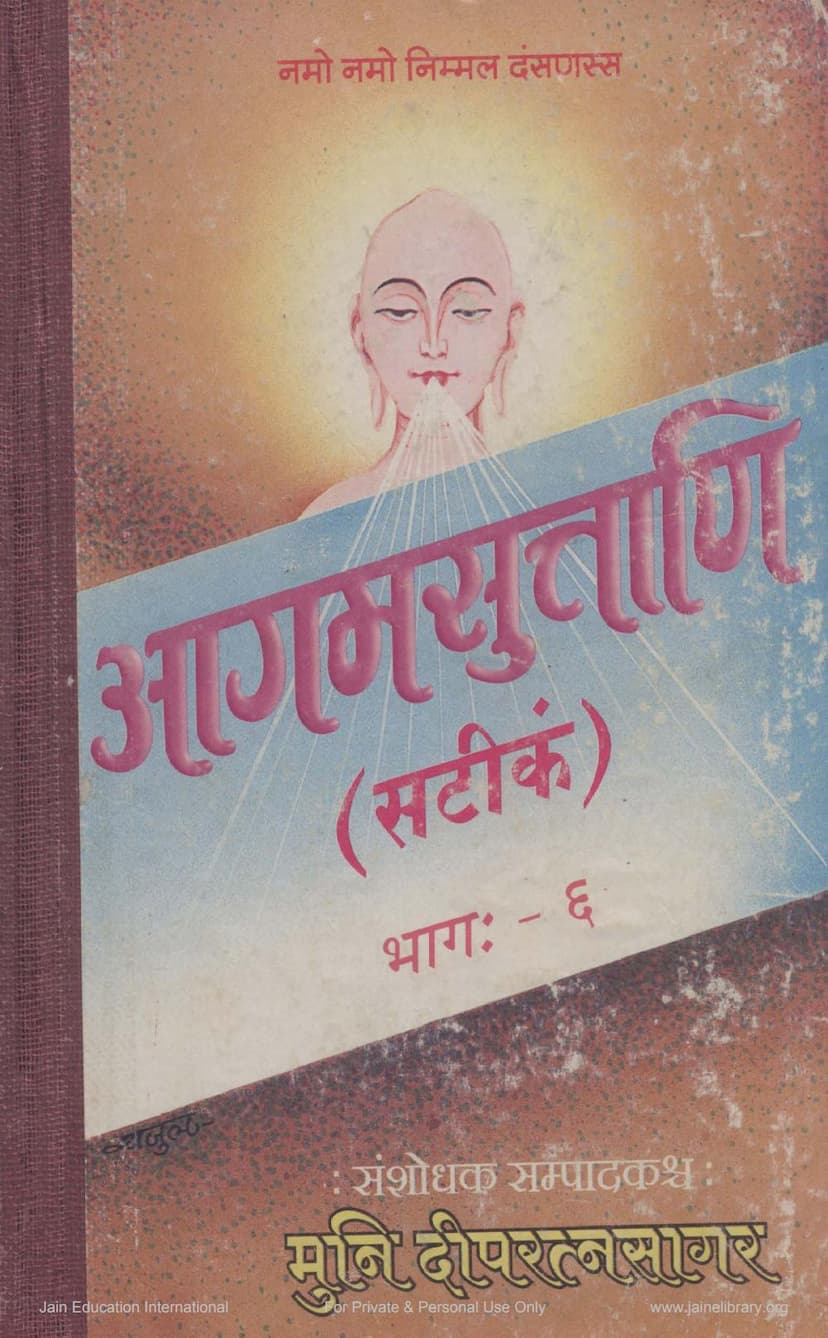Agam Suttani Satikam Part 06 Bhagvati
Added to library: September 1, 2025

Summary
This Jain text, "Agam Suttani Satikam Part 06 Bhagvati," is a commentary on the Bhagvati Sutra, one of the fundamental texts of the Jain Agamas. The provided pages offer a glimpse into the structure and content of this particular volume, which focuses on the eleventh chapter (Shatakam 11) and onwards.
Here's a comprehensive summary of the provided pages in English:
Overall Scope:
The text is a critical edition and commentary (Satikam) of the Bhagvati Anga Sutra, part of the Jain Agamas. This specific volume (Part 06) covers Shatakam 11 through Shatakam 24, with detailed subject indexes for each Shatakam, outlining its various sections (Uddeshak). The commentary is attributed to Muni Deepratnasagar and published by Agam Shrut Prakashan. The introductory pages include reverence to deities and gurus, indicating a religious and educational purpose.
Key Features and Content:
- Structure: The Bhagvati Sutra is divided into Shatakas (chapters) and Uddeshakas (sections within chapters). The provided index clearly lists the Uddeshakas covered in Shatakas 11 through 24, often with descriptive names for each Uddeshaka (e.g., Utpala, Shaluka, Palash in Shatakam 11). This suggests a systematic and detailed commentary.
- Content of Shatakam 11: The text begins with the commentary on Shatakam 11, which appears to deal with various aspects of classification and characteristics. The Uddeshaka titles suggest discussions on:
- Uddeshaka 1 (Utpala): Discusses topics like upapata (origin/rebirth), parimana (measure/quantity), ahara (food/sustenance), bandha (bondage), veda (feeling), udaya (arising), udirana (emission), leshya (soul-colouring), drishti (viewpoint), and jnana (knowledge). It also touches upon yogas, vows, body, substance, action, karma, senses, passions, and soul states.
- Subsequent Uddeshakas: The index indicates subsequent Uddeshakas in Shatakam 11 cover topics like Shaluuka, Palash, Kumbhi, Naalika, Padma, Karnika, Nalina, Shivarajrishi, Loka, Kala, and Alambika. This suggests a broad range of subjects, including classifications of beings, cosmology, and the teachings of sages.
- Comprehensive Index: Page 3 and subsequent pages present a detailed index of the topics covered from Shatakam 11 to Shatakam 24. This index is invaluable for understanding the vast scope of the Bhagvati Sutra and the detailed commentary provided. It lists subjects like:
- Elements and Substances: Earth, fire, water, air, body, soul, karma, substance (Pudgala).
- Cosmology: Loka (world), Aloka (non-world), various types of heavens and hells (Naraka), islands (Dweepa) and oceans (Samudra).
- Beings and their States: Classification of beings by senses (Ekendriya to Panchindriya), states of existence (Paryavasta), karma types, passions (Kashaya), knowledge, viewpoints (Drishti), soul-colourings (Leshyas), yogas, vows, and the omniscient (Kevali).
- Specific Topics: Topics like heat (Agni), sustenance (Ahaara), speech (Bhasha), conduct (Anagara Kriya), dreams (Swapna), time (Kala), place (Loka), karma, bondage, union (Samyog), and various classifications of beings are meticulously cataloged.
- Detailed Analysis of Subjects: The commentary (implied by "Satikam" and the detailed listing) likely delves into the philosophical, ethical, and cosmological aspects of Jainism as presented in the Bhagvati Sutra. The sheer number of topics indicates the text's depth and breadth.
- Commentary Style: The presence of 'Vr.' (Vritti, meaning commentary) before explanations of sutras suggests a scholarly approach, likely breaking down complex philosophical points and providing explanations.
- Authorship and Publication: Muni Deepratnasagar is credited as the compiler and editor, and Agam Shrut Prakashan is the publisher. The publication date is likely around April 14, 2000.
Content Summary from the Beginning of Shatakam 11 (Page 8 onwards):
The text begins the detailed commentary on Shatakam 11, starting with the first Uddeshaka titled "Utpala." The sutra (verse 498) is presented with its commentary. The initial discussion seems to revolve around the nature of beings, specifically whether they are single-celled or multi-celled (एगजीवे अनेगजीवे?). The commentary then proceeds to explain the process of rebirth (Upapata), the consequences of actions (karma), and various states of existence, likely drawing parallels to previous discussions on Vanaspati Kayika (plant-bodied beings). It also meticulously details the attributes of these beings, such as their lifespan, body size, colours, tastes, smells, and the types of karma they are associated with. The extensive questioning and answering format ("Kim?", "Goayama!" - "What?", "O Gautama!") is characteristic of classical Indian philosophical and religious dialogues.
Overall Purpose:
This volume serves as an authoritative resource for understanding the Bhagvati Sutra, a cornerstone of Jain philosophy. The commentary likely aims to clarify the intricate teachings of this scripture, making them accessible for study and practice. The emphasis on detailed subject matter and the meticulous referencing (e.g., citing other texts or sections) highlight its academic and devotional value within Jain traditions.
In essence, this text is a scholarly and devotional work dedicated to illuminating the profound and multifaceted teachings of the Bhagvati Sutra, covering a significant portion of its content from the eleventh to the twenty-fourth chapter.